

![]()
Ship strikes accounted for 15% of known North Atlantic right whale deaths from 2010-2015, down from 44% of known deaths from 1970-2009 but ship strikes are still a very serious and deadly threat to these whales.1 In the past year they have unfortunately returned as a major cause of death for them as at least five North Atlantic right whales were killed in Canada by ship strikes in 2017.2 Thankfully the Canadian government has implemented new speed restrictions in the Gulf of St. Lawrence in an effort to stop ship strike deaths.3 We support these efforts and hope they are expanded and made permanent.
Ship strike injuries to whales include large gashes or severed tails from propeller strikes and blunt trauma injuries such as fractured skulls, jaws, and vertebrae.4 One study about ship strikes on whales stated, "...Hundreds of fatal vessel collisions with large whales have been reported worldwide. In fact, the actual number of strikes is likely far greater than the reported number because many go undetected or unreported...Collisions with ships are a serious threat to the recovery of the highly depleted North Atlantic right whale."5 This particular study included other species of whales but ship strikes have a particularly bad effect on North Atlantic right whales because their population is already dangerously low.
One of the cases that comes to mind as we write about ship strikes is that of Delilah (NEAQ Catalog #1223), a North Atlantic right whale first seen in 1981. Delilah was killed in 1992 when she was struck by a ship and researchers at the New England Aquarium documented her painful death, noting that "Her death was not immediate, but the blunt force caused her to hemorrhage. A boater on the water that day photographed Delilah violently thrashing before she finally stopped breathing and became still." This was tragic enough but it was made worse by the fact that her eight month old calf was by her side when it happened.
Delilah's calf was thought to have not survived as it was previously believed that calves couldn't survive on their own at only eight months old. However, in July of 1993, researchers were looking over new pictures of right whales in the Bay of Fundy off Nova Scotia and matched the markings of one whale to one they had seen before, it was Delilah's calf. She had made it. Researchers decided to name her Calvin after the Calvin and Hobbes comics in honor of her resourcefulness and independent nature. Calvin has been entangled in fishing gear at least six times, once before she was even eight months old, and she was disentangled once by the Center for Coastal Studies in 2001.6
Sadly, she is not alone in her multiple entanglements because as we noted in the fact sheet on entanglements, 59% of North Atlantic right whales have been entangled in fishing gear more than once and in addition to that, there are at least four other whales besides Calvin who are known to have been entangled at least six times.7 Thankfully Calvin has still been able to push forward, giving birth to three calves of her own so far and was most recently seen in April of 2017 in Massachusetts Bay. We hope that she is seen again soon and that she can continue adding new calves to the population.
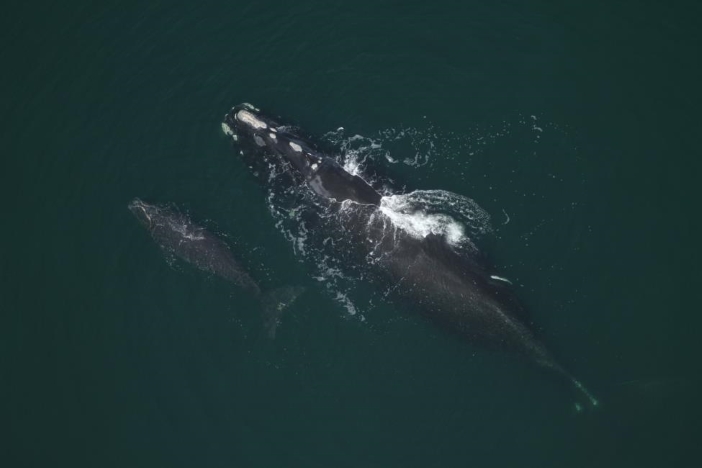
Calvin with her third calf off the Florida coast in the spring of 2015
Photo credit: Florida Fish and Wildlife Research Institute (FWRI)
Delilah's death became a rallying point in the 1990s to protect these whales from ship strikes and there are now regulations in place such as modifications to shipping lanes in areas where North Atlantic right whales are known to congregate.8,9 There are also mandatory speed restrictions in certain areas called Seasonal Management Areas (SMAs) and there are voluntary speed restrictions in areas called Dynamic Management Areas (DMAs). The areas shown in the map below are crucial to protect but unfortunately they only represent a small amount of their habitat and are only in place at certain times.
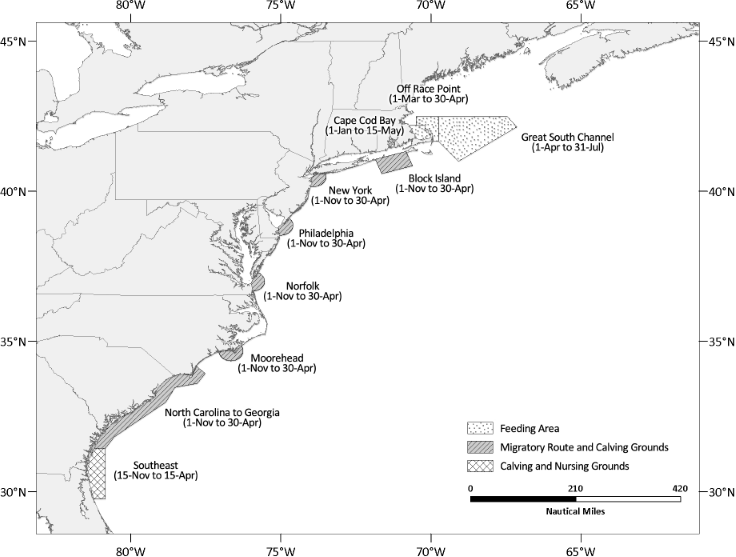
Seasonal Management Areas that have mandatory speed restrictions
Source: Compliance with vessel speed restrictions to protect North Atlantic right whales10
One study has suggested that the SMAs have helped since they were implemented in 2008 as deaths from ship strikes were reduced from an average of 2 per year from 2000 to 2006 to an average of 0.33 per year from 2007 to 2012.11 However, the authors of the study suggest that the Seasonal Management Areas be increased to improve the Rule's effectiveness.12 It is also concerning that compliance with the speed restrictions appears to be low. As stated in a recent study, "The rule's perceived ineffectiveness could be due to compliance, which has been low (20.7%–32.8% from 2009–2011) and is in many areas unknown."13 We hope that the speed restrictions are expanded and that all speed restrictions become mandatory because we believe that those individuals who don't comply with voluntary speed restrictions are the exact reason that mandatory restrictions are needed.
If you Like and Follow our Facebook page we can let you know any time public comments are needed for new regulations. Making our voices heard by submitting a quick comment to government agencies in support of new rules can go a long way in getting them implemented so that we can further protect these whales.
The NOAA is continuing their outreach to mariners14 about the speed restrictions and has released a guide on how to comply with them. We fully support these efforts and are continuing to spread the word about them. We hope you will share our fact sheet, and a link to their Compliance Guide, with any family or friends that may pilot boats. If you are piloting a boat please watch carefully for whales and remember that federal law and Massachusetts state law prohibit approaching a right whale closer than 500 yards unless permitted by the NOAA.
One recent death of a North Atlantic right whale caused by a ship strike was that of a calf who was found dead in the water near Chatham, Massachusetts on May 5, 2016. He was only five months old and was still nursing at the time of his death. He was the eighth calf of a well-known whale named Punctuation (Catalog #1281) and had been seen with her just a week earlier with no apparent injuries.15 The necropsy showed he had nine propeller cuts on his underside and multiple broken and fractured bones that were found to have been the cause of death.16 The Marine Mammal Commission stated that the calf "was estimated to have died two to four days prior to its necropsy on May 6th. A drift analysis suggests the calf was struck in the Race Point special management area, which requires large ships to limit their speed to 10 knots. However, the ship strike apparently occurred just a few days after the seasonal effective period for the area’s speed restrictions ended on April 30th."17
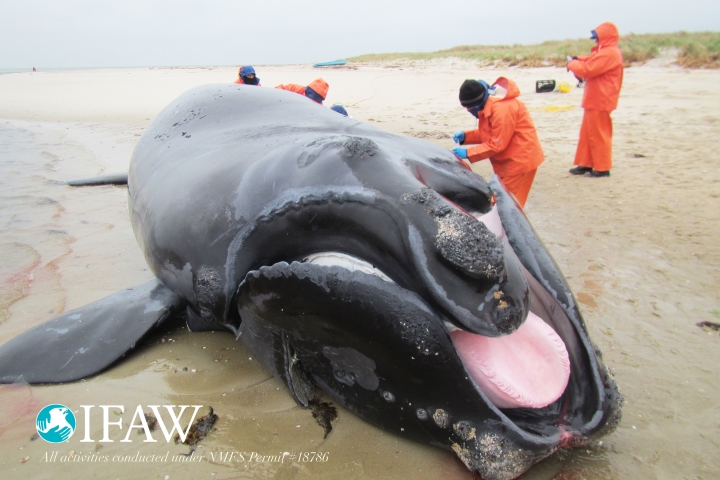
Punctuation's 8th calf on the beach in May 2016 after being towed in for a necropsy
Photo credit: International Fund for Animal Welfare (IFAW) - taken under NMFS permit #18786
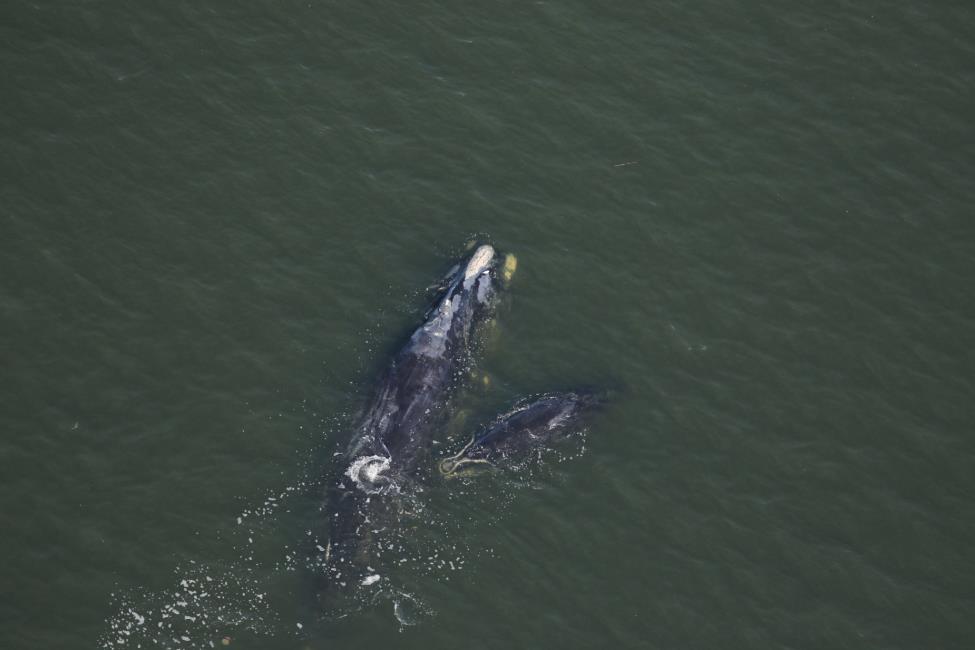
Punctuation with her calf in Georgia, January 2016
Photo credit: Georgia Department of Natural Resources/Sea to Shore Alliance
The death of this calf just days after the speed restrictions ended is particulary upsetting and shows just how crucial it is to expand the duration of the Special Management Areas and that the speed restrictions continue to be enforced. With the death of one whale affecting the future of the species there is no time to waste in expanding the protections for these whales. With this in mind we recommend that mariners stick to the speed restrictions any time and any place they're piloting a boat, not just when they're officially in effect.
His death is made even worse by the fact that he was one of only 14 calves born in the winter of 2016. There was fear that perhaps his mother had been injured or killed by the same ship as they were most likely together when it happened but thankfully she was spotted in the Gulf of St. Lawrence in Canada during the summer of 2016 and appeared uninjured. However, she has scars on her side from a previous encounter with a propeller at some point in her life, further showing that generation after generation of North Atlantic right whales have faced relentless injuries and deaths from human activity.
The resilience of whales like Calvin and Punctuation give us hope for the future but they shouldn't need such resilience. They shouldn't have to suffer at the hands of humans like they do now. We see time and time again that their strength and resilience can't save them so much of the time and that they are still at risk of extinction. They're up against a world that humans have made very unsafe for them but if we simply treat these amazing whales and the ocean they live in with respect and care then their population can bounce back and they can thrive - we just need to give them a fighting chance.
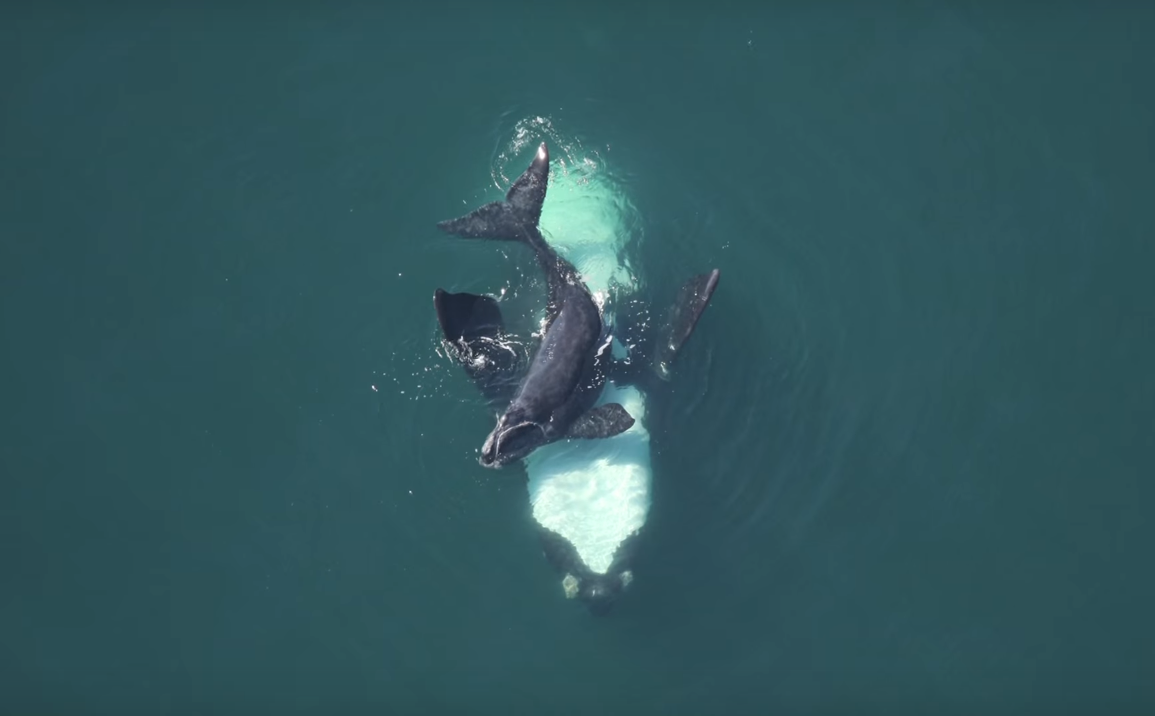
North Atlantic right whale 'Gannet' (Catalog #2660) cradling her one month old calf in waters off of Florida in 2011.
Photo credit: Florida Fish & Wildlife Conservation Commission. Taken under NOAA Research Permit #549-1759.
Sources:
1Endangered right whale population threatened by entanglements and dramatically declining birth rate - https://www.sciencedaily.com/releases/2016/09/160901092829.htm - back to paragraph
2North Atlantic Right Whale Consortium 2017 Report Card - page 6 - https://www.narwc.org/uploads/1/1/6/6/116623219/2017_report_cardfinal.pdf - back to paragraph
3Protections for right whales in Gulf of St. Lawrence strengthened for 2018 - The Telegram - 3/28/2018 - https://www.thetelegram.com/news/protections-for-right-whales-in-gulf-of-st-lawrence-strengthened-for-2018-197330/ - back to paragraph
4Collisions between ships and whales, Marine Mammal Science, 17(1):35–75 (January 2001) - page 12 - https://www.mmc.gov/wp-content/uploads/shipstrike.pdf - back to paragraph
5Compliance with vessel speed restrictions to protect North Atlantic right whales - page 2 - https://www.ncbi.nlm.nih.gov/pmc/articles/PMC4060020/pdf/peerj-02-399.pdf - back to paragraph
6New England Aquarium Right Whale Research Blog - 12-3-2014 - http://rightwhales.neaq.org/2014/12/sponsor-right-whale-calvin.html - back to paragraph
7Monitoring North Atlantic right whale (Eubalaena glacialis) entanglement rates: a 30 yr retrospective - page 297 - http://www.int-res.com/articles/meps_oa/m466p293.pdf - back to paragraph
8NEAQ Right Whale Research Blog - 10/7/2008 - http://rightwhales.neaq.org/2008/10/33-safer-havens-for-right-whales-in.php - back to paragraph
9NOAA: North Atlantic Right Whale Conservation Efforts - http://www.nmfs.noaa.gov/pr/species/mammals/whales/north-atlantic-right-whale.html#conservation - back to paragraph
10Compliance with vessel speed restrictions to protect North Atlantic right whales - June 3, 2014 - https://peerj.com/articles/399/ - back to paragraph
11Vessel Strikes to Large Whales Before and After the 2008 Ship Strike Rule - Full Study - http://onlinelibrary.wiley.com/doi/10.1111/conl.12105/full - back to paragraph
12Vessel Strikes to Large Whales Before and After the 2008 Ship Strike Rule - Summary - http://onlinelibrary.wiley.com/doi/10.1111/conl.12105/abstract - back to paragraph
13Vessel Strikes to Large Whales Before and After the 2008 Ship Strike Rule - Silber, G.K. & Bettridge, S. (2012) An assessment of the Final Rule to implement vessel speed restrictions to reduce the threat of vessel collisions with North Atlantic right whales. 114 pp. US Department of Commerce, NOAA Technical Memorandum NMFS-OPR-48. - http://onlinelibrary.wiley.com/doi/10.1111/conl.12105/full - back to paragraph
14NOAA Fisheries Service North Atlantic Right Whale 5-Year Review, August 2012 - page 17 - http://www.nmfs.noaa.gov/pr/pdfs/species/narightwhale_5yearreview.pdf - back to paragraph
15NOAA Fisheries - Chatham Right Whale Calf Mortality Update - https://www.greateratlantic.fisheries.noaa.gov/stories/2016/may/13_chatham_right_whale_calf_mortality_update.html - back to paragraph
16Right Whale Research Blog: Punctuation's Calf - 6-30-2016 - http://www.andersoncabotcenterforoceanlife.org/blog/1068/ - back to paragraph
17Marine Mammal Commission - Ship Strikes and Right Whales https://www.mmc.gov/priority-topics/species-of-concern/north-atlantic-right-whale/ship-strikes/ - back to paragraph